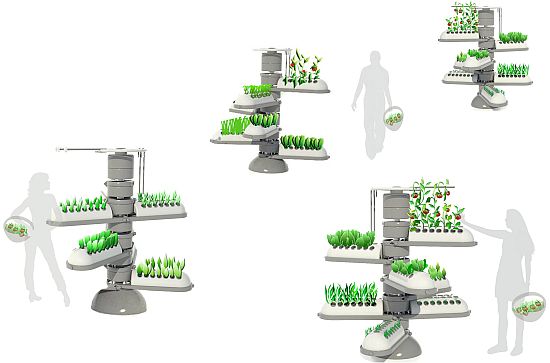
Compared to hydroponics, aeroponics offers even more control over the root system, because you don’t even need to immerse the roots in any liquid.
This makes your aeroponic nursery “mobile.” Aeroponics uses a small internal microjet spray that sprays the roots with fine, high pressure mist containing nutrient rich solutions. Because the roots are exposed to more oxygen, the plant tends to grow faster. It is also easier to administer all sorts of nutrients to the plant, via the root system.
In a typical aeroponic system, plants are usually suspended on top of a reservoir, within a tightly sealed container. A pump and sprinkler system creates vapors out of a nutrient rich solution, and sprays the result in the reservoir, engulfing the dangling plant roots. Plants are inserted into the platform top holes and supported with collars. Aeroponics is often confused with hydroponics, since the two methods are similar and interchangeable, but In aeroponics the roots have no contact with any media, whereas in hydroponics, they do.
Some people think that aeroponically grown plants would be more frail than plants grown in the soil, but this is entirely false, as they are in fact even more well fed than most of their soil counterparts! Aeroponics can also be combined perfectly with hydroponics, to produce strong, healthy plants, as in hydro-aeroponics.
The secret of aeroponics lies in the increased oxygen available to the roots due to the lack of root zone media.
Some of the key benefits of aeroponics:
Fast plant growth – The chief feature of aeroponics. Plants grow fast because their roots have access to a lot of oxygen 24/7.
- Easy system maintenance – In aeroponics, all you need to maintain is the root chamber (the container housing the roots) which needs regular disinfecting, and periodically, the reservoir and irrigation channels. The constant semi-moist environment of the root chamber which invites bacterial growth is the only main drawback of all aeroponic system maintenance.
- Less need for nutrients and water – Aeroponic plants need less nutrients and water on average, because the nutrient absorption rate is higher, and plants usually respond to aeroponic systems by growing even more roots.
- Mobility – Plants, even whole nurseries, can be moved around without too much effort, as all that is required is moving the plants from one collar to another.
- Requires little space – You don’t need much space to start an aeroponics garden. Depending on the system, plants can be stacked up one on top of each other. Aeroponics is basically a modular system, which is perfect for maxing out limited space.
- Great educational value – You can learn a great deal about plants from aeroponics. Kids especially will love having a small aeroponic system to grow a pet plant, without having to get their hands dirty.
Key disadvantages of aeroponics
- Dependence on the system – A typical aeroponics system is made up of high pressure pumps, sprinklers and timers. If any of these break down, your plants can be damaged or killed easily.
- Technical knowledge required – You need a certain level of competency in running an aeroponic system. Knowledge of nutrients amounts required by your plant is essential, because you don’t have any soil to absorb excess/wrong nutrients supplied.
- Regular cleaning of the root chamber – The root chamber must not be contaminated, or else diseases may strike the roots. So you need to disinfect the root chamber every so often. Hydrogen peroxide is often used as disinfectant.
- High cost – Most aeroponic systems are not exactly cheap. Aeroponic systems may cost many hundreds of dollars each.
In conclusion, aeroponics is still a good way to learn how to master plant growth and learn about their needs, within a controlled environment.
The EZ Guide To Aeroponics, Hydroponics and Aquaponics: How to Create a Sustainable Food Supply